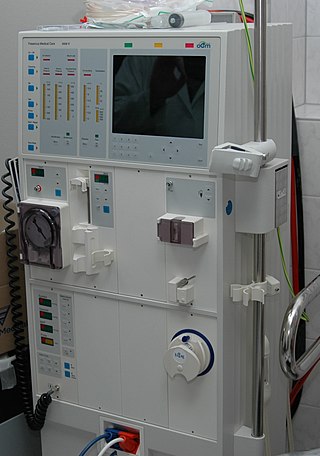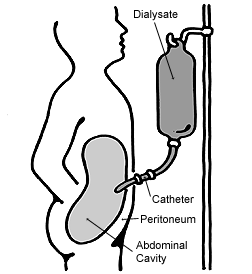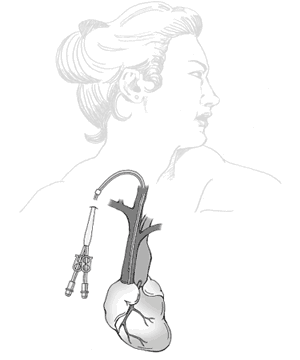In medicine, nocturnal dialysis, refers to (renal) dialysis done at night. It usually is a reference to nocturnal hemodialysis, but could also refer to peritoneal dialysis which is typically done at night.
Nocturnal hemodialysis was conceived by the late Dr. Robert Uldall at Wellesley Hospital in Toronto, Ontario, Canada. [1] The first patient trained was in April 1994. Conventional hemodialysis consists of a patient traveling to a clinic three times per week for a four-hour treatment. With nocturnal hemodialysis patients are trained to provide the treatments in their home six or seven nights per week for six to eight hours per treatment. There are some scientific studies which show benefits for patients using nocturnal hemodialysis versus conventional treatments, as well as many benefits that have not been studied yet.

Kidney dialysis is the process of removing excess water, solutes, and toxins from the blood in people whose kidneys can no longer perform these functions naturally. This is referred to as renal replacement therapy. The first successful dialysis was performed in 1943.

Kidney failure, also known as end-stage kidney disease, is a medical condition in which the kidneys can no longer adequately filter waste products from the blood, functioning at less than 15% of normal levels. Kidney failure is classified as either acute kidney failure, which develops rapidly and may resolve; and chronic kidney failure, which develops slowly and can often be irreversible. Symptoms may include leg swelling, feeling tired, vomiting, loss of appetite, and confusion. Complications of acute and chronic failure include uremia, high blood potassium, and volume overload. Complications of chronic failure also include heart disease, high blood pressure, and anemia.

Uremia is the term for high levels of urea in the blood. Urea is one of the primary components of urine. It can be defined as an excess of amino acid and protein metabolism end products, such as urea and creatinine, in the blood that would be normally excreted in the urine. Uremic syndrome can be defined as the terminal clinical manifestation of kidney failure. It is the signs, symptoms and results from laboratory tests which result from inadequate excretory, regulatory, and endocrine function of the kidneys. Both uremia and uremic syndrome have been used interchangeably to denote a very high plasma urea concentration that is the result of renal failure. The former denotation will be used for the rest of the article.

Hemodialysis, also spelled haemodialysis, or simply dialysis, is a process of purifying the blood of a person whose kidneys are not working normally. This type of dialysis achieves the extracorporeal removal of waste products such as creatinine and urea and free water from the blood when the kidneys are in a state of kidney failure. Hemodialysis is one of three renal replacement therapies. An alternative method for extracorporeal separation of blood components such as plasma or cells is apheresis.

Chronic kidney disease (CKD) is a type of kidney disease in which a gradual loss of kidney function occurs over a period of months to years. Initially generally no symptoms are seen, but later symptoms may include leg swelling, feeling tired, vomiting, loss of appetite, and confusion. Complications can relate to hormonal dysfunction of the kidneys and include high blood pressure, bone disease, and anemia. Additionally CKD patients have markedly increased cardiovascular complications with increased risks of death and hospitalization.

Peritoneal dialysis (PD) is a type of dialysis which uses the peritoneum in a person's abdomen as the membrane through which fluid and dissolved substances are exchanged with the blood. It is used to remove excess fluid, correct electrolyte problems, and remove toxins in those with kidney failure. Peritoneal dialysis has better outcomes than hemodialysis during the first couple of years. Other benefits include greater flexibility and better tolerability in those with significant heart disease.

A dialysis catheter is a catheter used for exchanging blood to and from a hemodialysis machine and a patient.

Home hemodialysis (HHD) is the provision of hemodialysis to purify the blood of a person whose kidneys are not working normally, in their own home. One advantage to doing dialysis at home is that it can be done more frequently and slowly, which reduces the "washed out" feeling and other symptoms caused by rapid ultrafiltration, and it can often be done at night, while the person is sleeping.
In medicine, Kt/V is a number used to quantify hemodialysis and peritoneal dialysis treatment adequacy.
Artificial kidney is often a synonym for hemodialysis, but may also refer to the other renal replacement therapies that are in use and/or in development. This article deals mainly with bioengineered kidneys/bioartificial kidneys that are grown from renal cell lines/renal tissue.
The urea reduction ratio (URR) is a dimensionless number used to quantify dialysis treatment adequacy.

Hemofiltration, also haemofiltration, is a renal replacement therapy which is used in the intensive care setting. It is usually used to treat acute kidney injury (AKI), but may be of benefit in multiple organ dysfunction syndrome or sepsis. During hemofiltration, a patient's blood is passed through a set of tubing via a machine to a semipermeable membrane where waste products and water are removed by convection. Replacement fluid is added and the blood is returned to the patient.
Standardized Kt/V, also std Kt/V, is a way of measuring (renal) dialysis adequacy. It was developed by Frank Gotch and is used in the United States to measure dialysis. Despite the name, it is quite different from Kt/V. In theory, both peritoneal dialysis and hemodialysis can be quantified with std Kt/V.
Renal replacement therapy (RRT) is therapy that replaces the normal blood-filtering function of the kidneys. It is used when the kidneys are not working well, which is called kidney failure and includes acute kidney injury and chronic kidney disease. Renal replacement therapy includes dialysis, hemofiltration, and hemodiafiltration, which are various ways of filtration of blood with or without machines. Renal replacement therapy also includes kidney transplantation, which is the ultimate form of replacement in that the old kidney is replaced by a donor kidney.

Calciphylaxis, also known as calcific uremic arteriolopathy (CUA) or “Grey Scale”, is a rare syndrome characterized by painful skin lesions. The pathogenesis of calciphylaxis is unclear but believed to involve calcification of the small blood vessels located within the fatty tissue and deeper layers of the skin, blood clots, and eventual death of skin cells due to lack of blood flow. It is seen mostly in people with end-stage kidney disease but can occur in the earlier stages of chronic kidney disease and rarely in people with normally functioning kidneys. Calciphylaxis is a rare but serious disease, believed to affect 1-4% of all dialysis patients. It results in chronic non-healing wounds and indicates poor prognosis, with typical life expectancy of less than one year.
Vascular access refers to a rapid, direct method of introducing or removing devices or chemicals from the bloodstream. In hemodialysis, vascular access is used to remove the patient's blood so that it can be filtered through the dialyzer. Three primary methods are used to gain access to the blood: an intravenous catheter, an arteriovenous fistula (AV) or a synthetic graft. In the latter two, needles are used to puncture the graft or fistula each time dialysis is performed.

Dialysis disequilibrium syndrome (DDS) is the collection of neurological signs and symptoms, attributed to cerebral edema, during or following shortly after intermittent hemodialysis or CRRT.

Robert Provenzano is an American nephrologist. He is also an Associate Clinical Professor of Medicine at Wayne State University School of Medicine.
The Rogosin Institute is an independent, not-for-profit treatment and research center with facilities throughout New York City that treat patients with kidney disease, including dialysis and kidney transplantation; lipid disorders; and hypertension. It is affiliated with NewYork-Presbyterian Hospital, Weill Cornell Medical College and is a leader in research programs for cancer and diabetes.

The Sindh Institute of Urology & Transplantation (SIUT) is a dialysis & kidney transplant centre located in Pakistan. SIUT was founded by Dr. Adibul Hasan Rizvi and it is Pakistan's largest kidney disease center, as well as Pakistan's largest public sector health organisation. It began as a department of urology at the government-run Civil Hospital in 1970 and became autonomous in 1991. Ten to twelve transplants are performed weekly, and in 2003, doctors at SIUT performed Pakistan's first liver transplant. In 2004, a child care unit was opened.